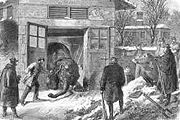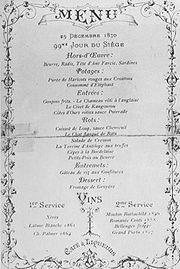
Castor and Pollux (elephants)
Encyclopedia

Elephant
Elephants are large land mammals in two extant genera of the family Elephantidae: Elephas and Loxodonta, with the third genus Mammuthus extinct...
s kept at the zoo
Zoo
A zoological garden, zoological park, menagerie, or zoo is a facility in which animals are confined within enclosures, displayed to the public, and in which they may also be bred....
Jardin des Plantes
Jardin des Plantes
The Jardin des Plantes is the main botanical garden in France. It is one of seven departments of the Muséum national d'histoire naturelle. It is situated in the 5ème arrondissement, Paris, on the left bank of the river Seine and covers 28 hectares .- Garden plan :The grounds of the Jardin des...
in Paris
Paris
Paris is the capital and largest city in France, situated on the river Seine, in northern France, at the heart of the Île-de-France region...
. They were killed and eaten, along with many other animals from the zoo, in late 1870 during the siege of Paris
Siege of Paris
The Siege of Paris, lasting from September 19, 1870 – January 28, 1871, and the consequent capture of the city by Prussian forces led to French defeat in the Franco-Prussian War and the establishment of the German Empire as well as the Paris Commune....
. The two elephants may have been siblings, and had been popular before the siege for giving rides on their backs around the park, but the food shortages caused by the German blockade of the city eventually drove the citizens of Paris to kill them for their meat.
On 19 September 1870, Prussian forces encircled Paris. Rather than bombarding the city into surrender the German high command decided to blockade the city to force a quick surrender. The Parisians managed to hold out until 28 January 1871 (when they surrendered after three days of shelling ordered by Otto von Bismarck
Otto von Bismarck
Otto Eduard Leopold, Prince of Bismarck, Duke of Lauenburg , simply known as Otto von Bismarck, was a Prussian-German statesman whose actions unified Germany, made it a major player in world affairs, and created a balance of power that kept Europe at peace after 1871.As Minister President of...
who had tired of the ineffective tactics of the high command). During the siege food became scarce and the populace were forced to turn to unusual sources for their meat.

Horse meat
Horse meat is the culinary name for meat cut from a horse. It is a major meat in only a few countries, notably in Central Asia, but it forms a significant part of the culinary traditions of many others, from Europe to South America to Asia. The top eight countries consume about 4.7 million horses...
. Horse meat had been introduced by the butchers of Paris four years earlier as a cheap alternative source of meat for the poor, but under siege conditions it quickly became a luxury item. Though there were large numbers of horses in Paris (estimates suggested between 65,000 and 70,000 were butchered and eaten during the siege) the supplies were ultimately limited. Champion racehorses were not spared (even two horses presented to Napoleon III by Alexander II of Russia
Alexander II of Russia
Alexander II , also known as Alexander the Liberator was the Emperor of the Russian Empire from 3 March 1855 until his assassination in 1881...
were slaughtered) but the meat soon became scarce. Cats, dogs and rats were the next selection for the menu. There was no control over rationing until late in the siege, so while the poor struggled, the wealthy Parisians ate comparatively well; the Jockey Club offered a fine selection of gourmet dishes of the unusual meats including Salmis de rats à la Robert. There were considerably fewer cats and dogs in the city than there had been horses, and the unpalatable rats were difficult to prepare, so, by the end of 1870, the butchers turned their attentions to the animals of the zoos. The large herbivore
Herbivore
Herbivores are organisms that are anatomically and physiologically adapted to eat plant-based foods. Herbivory is a form of consumption in which an organism principally eats autotrophs such as plants, algae and photosynthesizing bacteria. More generally, organisms that feed on autotrophs in...
s, such as the antelope
Antelope
Antelope is a term referring to many even-toed ungulate species indigenous to various regions in Africa and Eurasia. Antelopes comprise a miscellaneous group within the family Bovidae, encompassing those old-world species that are neither cattle, sheep, buffalo, bison, nor goats...
, camel
Camel
A camel is an even-toed ungulate within the genus Camelus, bearing distinctive fatty deposits known as humps on its back. There are two species of camels: the dromedary or Arabian camel has a single hump, and the bactrian has two humps. Dromedaries are native to the dry desert areas of West Asia,...
s, yak
Yak
The yak, Bos grunniens or Bos mutus, is a long-haired bovine found throughout the Himalayan region of south Central Asia, the Tibetan Plateau and as far north as Mongolia and Russia. In addition to a large domestic population, there is a small, vulnerable wild yak population...
s and zebra
Zebra
Zebras are several species of African equids united by their distinctive black and white stripes. Their stripes come in different patterns unique to each individual. They are generally social animals that live in small harems to large herds...
were first to be killed. Some animals survived: the monkey
Monkey
A monkey is a primate, either an Old World monkey or a New World monkey. There are about 260 known living species of monkey. Many are arboreal, although there are species that live primarily on the ground, such as baboons. Monkeys are generally considered to be intelligent. Unlike apes, monkeys...
s were thought to be too akin to humans to be killed, the lion
Lion
The lion is one of the four big cats in the genus Panthera, and a member of the family Felidae. With some males exceeding 250 kg in weight, it is the second-largest living cat after the tiger...
s and tiger
Tiger
The tiger is the largest cat species, reaching a total body length of up to and weighing up to . Their most recognizable feature is a pattern of dark vertical stripes on reddish-orange fur with lighter underparts...
s were too dangerous, and the hippopotamus
Hippopotamus
The hippopotamus , or hippo, from the ancient Greek for "river horse" , is a large, mostly herbivorous mammal in sub-Saharan Africa, and one of only two extant species in the family Hippopotamidae After the elephant and rhinoceros, the hippopotamus is the third largest land mammal and the heaviest...
of the Jardin des Plantes also escaped because the price of 80,000 francs
French franc
The franc was a currency of France. Along with the Spanish peseta, it was also a de facto currency used in Andorra . Between 1360 and 1641, it was the name of coins worth 1 livre tournois and it remained in common parlance as a term for this amount of money...
demanded for it was beyond the reach of any of the butchers. Menus began to offer exotic dishes such as Cuissot de Loup, Sauce Chevreuil (Haunch of Wolf with a Deer
Deer
Deer are the ruminant mammals forming the family Cervidae. Species in the Cervidae family include white-tailed deer, elk, moose, red deer, reindeer, fallow deer, roe deer and chital. Male deer of all species and female reindeer grow and shed new antlers each year...
Sauce), Terrine d'Antilope aux truffes (Terrine
Terrine (food)
A terrine is a French forcemeat loaf similar to a pâté, made with more coarsely chopped ingredients. Terrines are usually served cold or at room temperature.- See also :* Terrine , the cooking vessel* Pâté* Galantine* Mousseline...
of Antelope with truffles), Civet de Kangourou (Kangaroo
Kangaroo
A kangaroo is a marsupial from the family Macropodidae . In common use the term is used to describe the largest species from this family, especially those of the genus Macropus, Red Kangaroo, Antilopine Kangaroo, Eastern Grey Kangaroo and Western Grey Kangaroo. Kangaroos are endemic to the country...
Stew) and Chameau rôti à l'anglaise (Camel roasted à l'anglaise)
The demise of the elephants was recorded in the Lettre-Journal de Paris (commonly known as the Gazette des Absents), a twice-weekly periodical published during the siege by Damase Jouaust and delivered, along with the mail, by balloon
Balloon (aircraft)
A balloon is a type of aircraft that remains aloft due to its buoyancy. A balloon travels by moving with the wind. It is distinct from an airship, which is a buoyant aircraft that can be propelled through the air in a controlled manner....
to avoid the encircling Prussian forces. The Gazette des Absents reported that Castor had been killed on 29 December 1870 and Pollux the following day, both by explosive steel-tipped bullets
Dum-dum
An expanding bullet is a bullet designed to expand on impact, increasing in diameter to limit penetration and/or produce a larger diameter wound. They are informally known as a Dum-dum or dumdum bullets...
fired from a range of 10 m by M. Devisme, but a menu from 25 December was already offering Consommé d'Eléphant so it is likely that the dates are wrong. The elephants were bought by M. Deboos of the Boucherie Anglaise in Boulevard Hausmann for 27,000 francs for the pair. M.Deboos did well out of the purchase: the trunks sold as a delicacy for 40 or 45 francs a pound, the other parts for about 10 to 14 francs a pound. By all accounts, elephant was not tasty. Thomas Gibson Bowles
Thomas Gibson Bowles
Thomas Gibson Bowles , generally known as Tommy Bowles, was the founder of the magazines The Lady and the English Vanity Fair, a sailor and the maternal grandfather of the Mitford sisters.-Parents:...
, who was in Paris during the siege, wrote that he had eaten camel, antelope, dog, donkey
Donkey
The donkey or ass, Equus africanus asinus, is a domesticated member of the Equidae or horse family. The wild ancestor of the donkey is the African Wild Ass, E...
, mule
Mule
A mule is the offspring of a male donkey and a female horse. Horses and donkeys are different species, with different numbers of chromosomes. Of the two F1 hybrids between these two species, a mule is easier to obtain than a hinny...
and elephant and of those he liked elephant the least. Henry Labouchère
Henry Labouchere
Henry Du Pré Labouchère was an English politician, writer, publisher and theatre owner in the Victorian and Edwardian eras. He married the actress Henrietta Hodson....
recorded:

